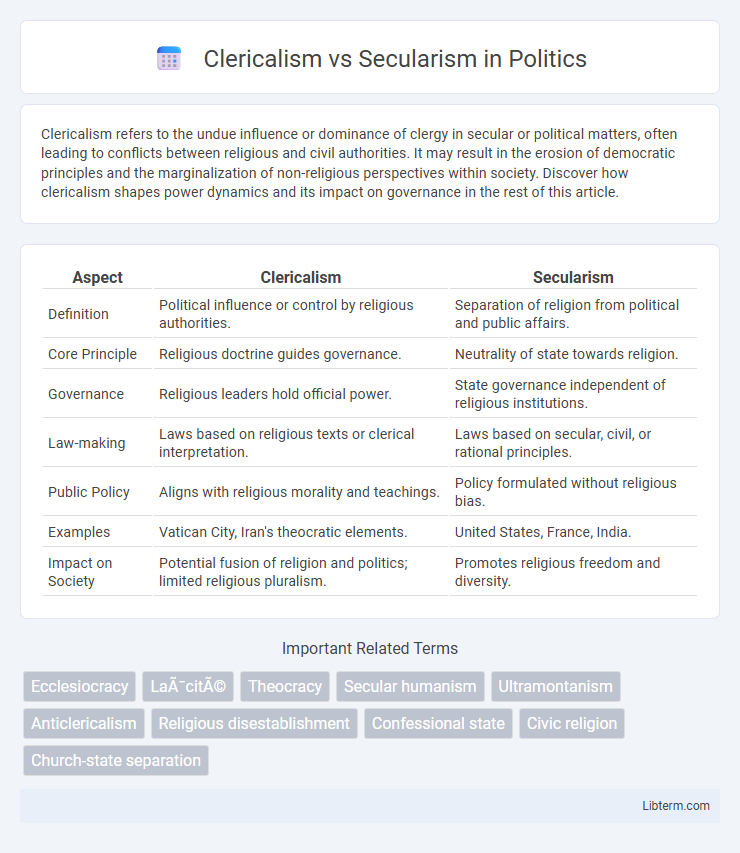Clericalism refers to the undue influence or dominance of clergy in secular or political matters, often leading to conflicts between religious and civil authorities. It may result in the erosion of democratic principles and the marginalization of non-religious perspectives within society. Discover how clericalism shapes power dynamics and its impact on governance in the rest of this article.
Table of Comparison
| Aspect | Clericalism | Secularism |
|---|---|---|
| Definition | Political influence or control by religious authorities. | Separation of religion from political and public affairs. |
| Core Principle | Religious doctrine guides governance. | Neutrality of state towards religion. |
| Governance | Religious leaders hold official power. | State governance independent of religious institutions. |
| Law-making | Laws based on religious texts or clerical interpretation. | Laws based on secular, civil, or rational principles. |
| Public Policy | Aligns with religious morality and teachings. | Policy formulated without religious bias. |
| Examples | Vatican City, Iran's theocratic elements. | United States, France, India. |
| Impact on Society | Potential fusion of religion and politics; limited religious pluralism. | Promotes religious freedom and diversity. |
Introduction to Clericalism and Secularism
Clericalism refers to the influence and authority of religious leaders in political and social matters, often emphasizing the integration of religious principles within governance. Secularism advocates for the separation of religion from governmental institutions, ensuring that public policies and laws remain neutral and free from religious influence. This dichotomy shapes debates on the role of religion in modern state affairs and the balance between faith and public governance.
Historical Roots of Clericalism
Clericalism emerged in the Middle Ages as the Christian Church consolidated religious and political power, intertwining ecclesiastical authority with governance. This fusion granted clergy significant influence over social institutions, shaping laws, education, and moral norms. The historical roots of clericalism reflect a hierarchical structure where religious leaders maintained control over secular affairs, contrasting with secularism's advocacy for the separation of church and state.
Evolution of Secularism: Key Movements
The evolution of secularism traces back to the Enlightenment era, marked by the emergence of key movements such as the French Revolution, which championed the separation of church and state. The rise of liberal democracy further advanced secular principles by promoting individual rights and freedom of religion, reducing clerical influence over governance. In the 20th century, landmark events like the establishment of the Indian secular constitution and the American First Amendment solidified secularism as a foundation for modern political systems.
Core Principles of Clericalism
Clericalism centers on the belief that religious leaders should hold authority not only in spiritual matters but also in political and social spheres, asserting the supremacy of religious institutions over secular governance. It emphasizes hierarchical control by clergy, often resisting secular legislation that contradicts religious doctrines. Core principles include the integration of church authority into state functions, prioritization of religious law, and the preservation of clerical privileges within society.
Secularism: Defining Values and Beliefs
Secularism emphasizes the separation of religious institutions from governmental and public affairs, advocating for neutrality in state policies regarding religion. It champions values such as individual freedom of belief, equality before the law regardless of religious affiliation, and the promotion of rational, evidence-based decision-making. Core beliefs include the protection of human rights, the prevention of religious privilege, and the support of a pluralistic society where diverse worldviews coexist without state endorsement.
Clericalism in Modern Society
Clericalism in modern society often manifests as the concentration of power within religious institutions, influencing political decisions and social norms while challenging secular governance. This fusion of religious authority and state affairs tends to shape public policy on issues ranging from education to human rights, sometimes undermining pluralism and democratic principles. The ongoing debate around clericalism highlights tensions between religious freedom and the secular state's commitment to neutrality and inclusiveness.
Secular Governance: Models and Examples
Secular governance entails a clear separation between religious institutions and state functions, ensuring laws and policies are based on civil authority rather than religious doctrine. Prominent models include the French laicite, which enforces strict state neutrality in religious matters, and the U.S. system that promotes freedom of religion while maintaining government neutrality. Countries like India adopt a form of secularism that accommodates multiple religions within government frameworks, highlighting diverse approaches to secular governance worldwide.
Social Impacts of Clericalism vs Secularism
Clericalism, by intertwining religious authority with political and social institutions, often reinforces traditional power structures and can limit pluralism and individual freedoms, impacting social cohesion and minority rights. Secularism promotes the separation of religion from state affairs, fostering inclusive governance, equal rights, and social diversity by ensuring no single religious ideology dominates public policy. The social impacts of clericalism tend to concentrate power within religious elites, while secularism encourages democratic participation and protects civil liberties across diverse populations.
Key Debates and Controversies
Clericalism vs secularism debates center on the role of religious authority in governance and public life, with clericalism advocating for the integration of religious institutions into political frameworks, while secularism insists on the separation of church and state to ensure religious neutrality. Controversies often arise over education policies, legal recognition of religious laws, and government endorsements of religious symbols, highlighting tensions between religious freedom and state impartiality. Key conflict areas include the influence of clericalism on legislative processes and secularism's efforts to restrict religious privilege in public spheres.
Future Trends: Balancing Faith and Secularity
Future trends in clericalism vs secularism will emphasize a dynamic equilibrium where religious influence and secular governance coexist without dominance. Increasing pluralism and digital connectivity promote dialogue between faith-based institutions and secular authorities, fostering mutual respect and collaboration. Innovations in policy-making are likely to integrate ethical values from both perspectives to address global challenges such as human rights, environmental sustainability, and social justice.
Clericalism Infographic

 libterm.com
libterm.com